Vega VEGAPULS 62 User manual

Operating Instructions
Radar sensor for continuous level
measurement of liquids
VEGAPULS 62
Probus PA
Document ID: 36505

2
Contents
VEGAPULS 62 • Probus PA
36505-EN-181127
Contents
1 About this document ............................................................................................................... 4
1.1 Function ........................................................................................................................... 4
1.2 Target group ..................................................................................................................... 4
1.3 Symbols used................................................................................................................... 4
2 For your safety ......................................................................................................................... 5
2.1 Authorised personnel ....................................................................................................... 5
2.2 Appropriate use................................................................................................................ 5
2.3 Warning about incorrect use............................................................................................. 5
2.4 General safety instructions............................................................................................... 5
2.5 EU conformity................................................................................................................... 6
2.6 NAMUR recommendations .............................................................................................. 6
2.7 Radio license for Europe .................................................................................................. 6
2.8 Radio license for USA ...................................................................................................... 6
2.9 Radio license for Canada ................................................................................................. 7
2.10 Installation and operation in the USA and Canada ........................................................... 9
2.11 Environmental instructions ............................................................................................... 9
3 Product description ............................................................................................................... 11
3.1 Conguration.................................................................................................................. 11
3.2 Principle of operation...................................................................................................... 12
3.3 Packaging, transport and storage................................................................................... 13
3.4 Accessories and replacement parts ............................................................................... 13
4 Mounting................................................................................................................................. 16
4.1 General instructions ....................................................................................................... 16
4.2 Mounting preparations ................................................................................................... 17
4.3 Mounting instructions ..................................................................................................... 18
4.4 Measurement setup - Pipes ........................................................................................... 25
4.5 Measurement setup - Flow............................................................................................. 30
5 Connecting to the bus system.............................................................................................. 32
5.1 Preparing the connection ............................................................................................... 32
5.2 Connecting..................................................................................................................... 33
5.3 Wiring plan, single chamber housing.............................................................................. 34
5.4 Wiring plan, double chamber housing ............................................................................ 34
5.5 Wiring plan, Ex-d-ia double chamber housing................................................................ 36
5.6 Double chamber housing with VEGADIS-Adapter.......................................................... 37
5.7 Wiring plan - version IP 66/IP 68, 1 bar........................................................................... 38
5.8 Set instrument address .................................................................................................. 38
5.9 Switch-on phase............................................................................................................. 39
6 Set up with the display and adjustment module ................................................................ 40
6.1 Insert display and adjustment module............................................................................ 40
6.2 Adjustment system......................................................................................................... 41
6.3 Measured value indication - Selection of national language........................................... 42
6.4 Parameter adjustment .................................................................................................... 43
6.5 Saving the parameterisation data................................................................................... 62
7 Setup with PACTware............................................................................................................. 63
7.1 Connect the PC.............................................................................................................. 63
7.2 Parameter adjustment .................................................................................................... 63

3
Contents
VEGAPULS 62 • Probus PA
36505-EN-181127
7.3 Saving the parameterisation data................................................................................... 64
8 Set up with other systems .................................................................................................... 65
8.1 DD adjustment programs ............................................................................................... 65
9 Diagnosis, asset management and service ........................................................................ 66
9.1 Maintenance .................................................................................................................. 66
9.2 Measured value and event memory ............................................................................... 66
9.3 Asset Management function........................................................................................... 67
9.4 Rectify faults................................................................................................................... 70
9.5 Exchanging the electronics module................................................................................ 74
9.6 Software update ............................................................................................................. 74
9.7 How to proceed if a repair is necessary.......................................................................... 75
10 Dismount................................................................................................................................. 76
10.1 Dismounting steps.......................................................................................................... 76
10.2 Disposal ......................................................................................................................... 76
11 Supplement ............................................................................................................................ 77
11.1 Technical data ................................................................................................................ 77
11.2 Communication Probus PA........................................................................................... 86
11.3 Dimensions .................................................................................................................... 91
11.4 Industrial property rights............................................................................................... 100
11.5 Trademark .................................................................................................................... 100
Safety instructions for Ex areas
Take note of the Ex specic safety instructions for Ex applications.
These instructions are attached as documents to each instrument
with Ex approval and are part of the operating instructions.
Editing status: 2018-11-23

4
1 About this document
VEGAPULS 62 • Probus PA
36505-EN-181127
1 About this document
1.1 Function
This operating instructions provides all the information you need for
mounting, connection and setup as well as important instructions for
maintenance, fault rectication, the exchange of parts and the safety
of the user. Please read this information before putting the instrument
into operation and keep this manual accessible in the immediate
vicinity of the device.
1.2 Target group
This operating instructions manual is directed to trained personnel.
The contents of this manual must be made available to the qualied
personnel and implemented.
1.3 Symbols used
Document ID
This symbol on the front page of this instruction refers to the Docu-
ment ID. By entering the Document ID on www.vega.com you will
reach the document download.
Information, tip, note
This symbol indicates helpful additional information.
Caution: If this warning is ignored, faults or malfunctions can result.
Warning: If this warning is ignored, injury to persons and/or serious
damage to the instrument can result.
Danger: If this warning is ignored, serious injury to persons and/or
destruction of the instrument can result.
Ex applications
This symbol indicates special instructions for Ex applications.
• List
The dot set in front indicates a list with no implied sequence.
→ Action
This arrow indicates a single action.
1 Sequence of actions
Numbers set in front indicate successive steps in a procedure.
Battery disposal
This symbol indicates special information about the disposal of bat-
teries and accumulators.

5
2 For your safety
VEGAPULS 62 • Probus PA
36505-EN-181127
2 For your safety
2.1 Authorised personnel
All operations described in this documentation must be carried out
only by trained, qualied personnel authorised by the plant operator.
During work on and with the device, the required personal protective
equipment must always be worn.
2.2 Appropriate use
VEGAPULS 62 is a sensor for continuous level measurement.
You can nd detailed information about the area of application in
chapter "Product description".
Operational reliability is ensured only if the instrument is properly
used according to the specications in the operating instructions
manual as well as possible supplementary instructions.
2.3 Warning about incorrect use
Inappropriate or incorrect use of this product can give rise to applica-
tion-specic hazards, e.g. vessel overll through incorrect mounting
or adjustment. Damage to property and persons or environmental
contamination can result. Also, the protective characteristics of the
instrument can be impaired.
2.4 General safety instructions
This is a state-of-the-art instrument complying with all prevailing
regulations and directives. The instrument must only be operated in a
technically awless and reliable condition. The operator is responsi-
ble for the trouble-free operation of the instrument. When measuring
aggressive or corrosive media that can cause a dangerous situation
if the instrument malfunctions, the operator has to implement suitable
measures to make sure the instrument is functioning properly.
During the entire duration of use, the user is obliged to determine the
compliance of the necessary occupational safety measures with the
current valid rules and regulations and also take note of new regula-
tions.
The safety instructions in this operating instructions manual, the na-
tional installation standards as well as the valid safety regulations and
accident prevention rules must be observed by the user.
For safety and warranty reasons, any invasive work on the device
beyond that described in the operating instructions manual may be
carried out only by personnel authorised by the manufacturer. Arbi-
trary conversions or modications are explicitly forbidden. For safety
reasons, only the accessory specied by the manufacturer must be
used.
To avoid any danger, the safety approval markings and safety tips on
the device must also be observed and their meaning read in this oper-
ating instructions manual.

6
2 For your safety
VEGAPULS 62 • Probus PA
36505-EN-181127
Depending on the instrument version, the emitting frequencies are in
the C, K or W band range. The low emission power is far below the
internationally approved limit values. When used correctly, the device
poses no danger to health.
2.5 EU conformity
The device fulls the legal requirements of the applicable EU direc-
tives. By axing the CE marking, we conrm the conformity of the
instrument with these directives.
You can nd the EU conformity declaration on our website under
www.vega.com/downloads.
Electromagnetic compatibility
Instruments in four-wire or Ex-d-ia version are designed for use in an
industrial environment. Nevertheless, electromagnetic interference
from electrical conductors and radiated emissions must be taken into
account, as is usual with class A instruments according to EN 61326-
1. If the instrument is used in a dierent environment, the electromag-
netic compatibility to other instruments must be ensured by suitable
measures.
2.6 NAMUR recommendations
NAMUR is the automation technology user association in the process
industry in Germany. The published NAMUR recommendations are
accepted as the standard in eld instrumentation.
The device fulls the requirements of the following NAMUR recom-
mendations:
• NE 21 – Electromagnetic compatibility of equipment
• NE 53 – Compatibility of eld devices and display/adjustment
components
• NE 107 - Self-monitoring and diagnosis of eld devices
For further information see www.namur.de.
2.7 Radio license for Europe
The instrument was tested according to the latest issue of the follow-
ing harmonized standards:
• EN 302372 - Tank Level Probing Radar
It is hence approved for use inside closed vessels in countries of the
EU.
Use is also approved in EFTA countries, provided the respective
standards have been implemented.
For operation inside of closed vessels, points a to f in annex E of
EN 302372 must be fullled.
2.8 Radio license for USA
This approval is only valid for USA. Hence the following text is only
available in the English language.

7
2 For your safety
VEGAPULS 62 • Probus PA
36505-EN-181127
This device complies with Part 15 of the FCC Rules. Operation is
subject to the following two conditions:
• This device may not cause interference, and
• This device must accept any interference, including interference
that may cause undesired operation of the device
This device is approved for unrestricted use only inside closed, sta-
tionary vessels made of metal, concrete and reinforced berglass.
For operation outside of closed vessels, the following conditions must
be fullled:
• This device shall be installed and maintained to ensure a verti-
cally downward orientation of the transmit antenna's main beam.
Furthermore, the use of any mechanism that does not allow the
main beam of the transmitter to be mounted vertically downward is
prohibited.
• Operation of the instrument with horn antennas ø 40 mm and
ø 48 mm is only permitted within closed vessels.
• Operation of the instrument with parabolic antenna (ø 245 mm)
in conjunction with the electronics with increased sensitivity
(PS60HS) is only permitted within closed vessels.
• This device shall be installed only at xed locations. The LPR
device shall not operate while being moved or while inside a mov-
ing container.
• Hand-held applications are prohibited.
• Marketing to residential consumers is prohibited.
Changes or modications not expressly approved by the manufac-
turer could void the user’s authority to operate this equipment.
2.9 Radio license for Canada
This approval is only valid for Canada. Hence the following texts are
only available in the English/French language.
This device complies with Industry Canada's license-exempt RSS
standards. Operation is subject to the following conditions:
• This device may not cause interference, and
• This device must accept any interference, including interference
that may cause undesired operation of the device
This device has been approved for both closed containers and open-
air environments with the following limitations:
• Closed Containers: For installations utilizing a tilt during installa-
tion: This device is limited to installation in a completely enclosed
container made of metal, concrete or reinforced berglass to pre-
vent RF emissions, which can otherwise interfere with aeronauti-
cal navigation, the maximum approved tilt angle is 10°.
• Open Air Environment: For operation outside of closed vessels,
the following condition must be fullled: This device shall be
installed and maintained to ensure a vertically downward orienta-
tion of the transmit antenna's main beam. Furthermore, the use of
any mechanism that does not allow the main beam of the transmit-
ter to be mounted vertically downward is prohibited.

8
2 For your safety
VEGAPULS 62 • Probus PA
36505-EN-181127
• Operation of the instrument with horn antennas ø 40 mm and
ø 48 mm is only permitted within closed vessels.
• Operation of the instrument with parabolic antenna (ø 245 mm)
in conjunction with the electronics with increased sensitivity
(PS60HS) is only permitted within closed vessels.
The installation of the LPR/TLPR device shall be done by trained
installers, in strict compliance with the manufacture's instructions.
This device shall be installed only at xed locations. The LPR device
shall not operate while being moved or while inside a moving con-
tainer.
Hand-held applications are prohibited.
Marketing to residential consumers is prohibited.
The use of this device is on a "no-interference, no-protection" basis.
That ist, the user shall accept operatings of high-powered radaar in
the same frequency band which may interfere with or damage this
device.
However, devices found to interfere with primary licensing operations
will be required to be removed at the user's expense.
The installer/user of this device shall ensure that it is at least 10 km
from the Dominion Astrophysical Radio Observatory (DRAO) near
Penticton, British Columbia. The coordinates of the DRAO are latitude
49°19′15″ N and longitude 119°37′12″W. For devices not meeting
this 10 km separation (e.g., those in the Okanagan Valley, British Co-
lumbia,) the installer/user must coordinate with, and obtain the written
concurrence of, the Director of the DRAO before the equipment can
be installed or operated. The Director of the DRAO may be contacted
at 250-497-2300 (tel.)or 250-497-2355 (fax). (Alternatively, the Man-
ager, Regulatory Standards, Industry Canada, may be contacted.)
Le présent appareil est conforme aux CNR d’Industrie Canada ap-
plicables aux appareils radio exempts de licence. L’exploitation est
autorisée aux conditions suivantes :
• L’appareil ne doit pas produire de brouillage; et
• L’utilisateur de l’appareil doit accepter tout brouillage radioélect-
rique subi, même si le brouillage est susceptible d’en compromet-
tre le fonctionnement.
Cet appareil est homologué pour une utilisation dans les cuves fer-
mées et les environnements ouverts avec les restrictions suivantes :
• Cuves fermées : Pour les installations impliquant une inclinaison
lors de l'installation : cet appareil ne doit être installé que dans une
cuve totalement fermée en en métal, en béton ou en matière plas-
tiqe renforcée de bres de verre, pour empêcher les émissions RF
susceptibles d'interférer avec la navigation aéronautique. L'angle
d'inclinaison maximum autorisé est de 10°.
• Environnement ouvert : Pour l'utilisation hors des cuves fermées,
la condition suivante doit être remplie : L'appareil doit être installé
et entretenu de manière à garantir une orientation verticale vers
le bas du faisceau principal de l’antenne émettrice. De plus,

9
2 For your safety
VEGAPULS 62 • Probus PA
36505-EN-181127
l’utilisation de tout mécanisme ne permettant pas l’orientation ver-
ticale vers le bas du faisceau principal de l’émetteur est interdite
• Il est uniquement autorisé d'exploiter l'appareil avec les antennes
cônes ø 40 mm et ø 48 mm dans des boîtiers fermés.
• Il est uniquement autorisé d'exploiter l'appareil avec une antenne
parabolique (ø 245 mm) en liaison avec l'électronique à sensibilité
accrue (PS60HS) dans des boîtiers fermés.
L’installation d’un dispositif LPR ou TLPR doit être eectuée par des
installateurs qualiés, en pleine conformité avec les instructions du
fabricant.
Cet appareil ne doit être installé qu'à des emplacements xes.
L’appareil LPR ne doit pas être utilisé pendant qu’il est en train d’être
déplacé ou se trouve dans un conteneur en mouvement.
Les applications portables sont interdites.
La vente à des particuliers est interdite
Ce dispositif ne peut être exploité qu'en régime de non-brouillage
et de non-protection, c'est-à-dire que l'utilisateur doit accepter que
des radars de haute puissance de la même bande de fréquences
puissent brouiller ce dispositif ou même l'endommager. D'autre part,
les capteurs de niveau qui perturbent une exploitation autorisée par
licence de fonctionnement principal doivent être enlevés aux frais de
leur utilisateur.
La personne qui installe/utilise ce capteur de niveau doit s'assurer
qu'il se trouve à au moins 10 km de l'Observatoire fédéral de radio-
astrophysique (OFR) de Penticton en Colombie-Britannique. Les
coordonnées de l'OFR sont : latitude N 49° 19′ 15″, longitude O 119°
37′ 12″. La personne qui installe/utilise un dispositif ne pouvant re-
specter cette distance de 10 km (p. ex. dans la vallée de l'Okanagan
[Colombie-Britannique]) doit se concerter avec le directeur de
l'OFR an d’obtenir de sa part une autorisation écrite avant que
l'équipement ne puisse être installé ou mis en marche. Le directeur de
l'OFR peut être contacté au 250-497-2300 (tél.) ou au 250-497-2355
(fax). (Le Directeur des Normes réglementaires d'Industrie Canada
peut également être contacté).
2.10 Installation and operation in the USA and
Canada
This information is only valid for USA and Canada. Hence the follow-
ing text is only available in the English language.
Installations in the US shall comply with the relevant requirements of
the National Electrical Code (ANSI/NFPA 70).
Installations in Canada shall comply with the relevant requirements of
the Canadian Electrical Code.
2.11 Environmental instructions
Protection of the environment is one of our most important duties.
That is why we have introduced an environment management system
with the goal of continuously improving company environmental pro-

10
2 For your safety
VEGAPULS 62 • Probus PA
36505-EN-181127
tection. The environment management system is certied according
to DIN EN ISO 14001.
Please help us full this obligation by observing the environmental
instructions in this manual:
• Chapter "Packaging, transport and storage"
• Chapter "Disposal"

11
3 Product description
VEGAPULS 62 • Probus PA
36505-EN-181127
3 Product description
3.1 Conguration
The type label contains the most important data for identication and
use of the instrument:
2
1
15
13
14
12
11
5
3
6
4
7
8
10
9
Fig. 1: Layout of the type label (example)
1 Instrument type
2 Product code
3 Approvals
4 Power supply and signal output, electronics
5 Protection rating
6 Measuring range
7 Process and ambient temperature, process pressure
8 Material wetted parts
9 Hardware and software version
10 Order number
11 Serial number of the instrument
12 Data matrix code for VEGA Tools app
13 Symbol of the device protection class
14 ID numbers, instrument documentation
15 Reminder to observe the instrument documentation
The type label contains the serial number of the instrument. With it
you can nd the following instrument data on our homepage:
• Product code (HTML)
• Delivery date (HTML)
• Order-specic instrument features (HTML)
• Operating instructions and quick setup guide at the time of ship-
ment (PDF)
• Order-specic sensor data for an electronics exchange (XML)
• Test certicate (PDF) - optional
Go to "www.vega.com", "Search". Enter the serial number.
Alternatively, you can access the data via your smartphone:
• Download the VEGA Tools app from the "Apple App Store" or the
"Google Play Store"
• Scan the Data Matrix code on the type label of the instrument or
• Enter the serial number manually in the app
Type label
Serial number - Instru-
ment search

12
3 Product description
VEGAPULS 62 • Probus PA
36505-EN-181127
This operating instructions manual applies to the following instrument
versions:
• Hardware from 2.1.1
• Software from 4.5.2
The instrument is available in two dierent electronics versions. Each
version can be identied via the product code on the type label as
well as on the electronics.
• Standard electronics type PS60PAK.-
• Electronics with increased sensitivity type PS60PAS.-
The scope of delivery encompasses:
• Radar sensor
• Documentation
– Quick setup guide VEGAPULS 62
– Instructions for optional instrument features
– Ex-specic "Safety instructions" (with Ex versions)
– If necessary, further certicates
Information:
The optional instrument features are described in the operating
instructions manual. The respective scope of delivery results from the
order specication.
3.2 Principle of operation
The VEGAPULS 62 radar sensor can be used in a wide variety of ap-
plications for continuous level measurement of liquids. It is suitable for
applications in storage vessels, reactors and process vessels, even
under extremely dicult process conditions.
Dependent on the application range, dierent versions are used:
• Antenna
– Small tanks and process vessels, measurement of virtually all
products: Horn antenna ø 40 mm
– Storage tanks and process vessels, measurement of products
such as solvents, hydrocarbons and fuels under extremely dif-
cult process conditions: Horn antenna ø 48 … 95 mm
– Products with low εr value with large measuring distances:
Parabolic antenna
• Electronics
– Products with an εr value ≥ 1.8: Standard electronics
– Products with an εr value < 1.8, ≥1.5; applications with very bad
reective properties: Electronics with increased sensitivity
The actual values that can be reached depend on the measurement
conditions, the antenna system or the standpipe or bypass.
The antenna of the radar sensor emits short radar pulses with a
duration of approx. 1 ns. These pulses are reected by the product
and received by the antenna as echoes. The transit time of the radar
pulses from emission to reception is proportional to the distance and
Scope of this operating
instructions
Electronics versions
Scope of delivery
Application area
Functional principle

13
3 Product description
VEGAPULS 62 • Probus PA
36505-EN-181127
hence to the level. The determined level is converted into an appropri-
ate output signal and outputted as measured value.
3.3 Packaging, transport and storage
Your instrument was protected by packaging during transport. Its
capacity to handle normal loads during transport is assured by a test
based on ISO 4180.
The packaging of standard instruments consists of environment-
friendly, recyclable cardboard. For special versions, PE foam or PE
foil is also used. Dispose of the packaging material via specialised
recycling companies.
Transport must be carried out in due consideration of the notes on the
transport packaging. Nonobservance of these instructions can cause
damage to the device.
The delivery must be checked for completeness and possible transit
damage immediately at receipt. Ascertained transit damage or con-
cealed defects must be appropriately dealt with.
Up to the time of installation, the packages must be left closed and
stored according to the orientation and storage markings on the
outside.
Unless otherwise indicated, the packages must be stored only under
the following conditions:
• Not in the open
• Dry and dust free
• Not exposed to corrosive media
• Protected against solar radiation
• Avoiding mechanical shock and vibration
• Storage and transport temperature see chapter "Supplement -
Technical data - Ambient conditions"
• Relative humidity 20 … 85 %
With instrument weights of more than 18 kg (39.68 lbs) suitable and
approved equipment must be used for lifting and carrying.
3.4 Accessories and replacement parts
The display and adjustment module PLICSCOM is used for measured
value indication, adjustment and diagnosis. It can be inserted into the
sensor or the external display and adjustment unit and removed at
any time.
The integrated Bluetooth module (optional) enables wireless adjust-
ment via standard adjustment devices:
• Smartphone/tablet (iOS or Android operating system)
• PC/notebook with Bluetooth USB adapter (Windows operating
system)
You can nd further information in the operating instructions "Display
and adjustment module PLICSCOM" (Document-ID 36433).
Packaging
Transport
Transport inspection
Storage
Storage and transport
temperature
Lifting and carrying
PLICSCOM

14
3 Product description
VEGAPULS 62 • Probus PA
36505-EN-181127
The interface adapter VEGACONNECT enables the connection of
communication-capable instruments to the USB interface of a PC. For
parameter adjustment of these instruments, the adjustment software
PACTware with VEGA-DTM is required.
You can nd further information in the operating instructions "Interface
adapter VEGACONNECT" (Document-ID 32628).
The VEGADIS 81 is an external display and adjustment unit for VEGA
plics®sensors.
For sensors with double chamber housing the interface adapter
"VEGADIS adapter" is also required for VEGADIS 81.
You can nd further information in the operating instructions
"VEGADIS 81" (Document-ID 43814).
The VEGADIS adapter is an accessory part for sensors with double
chamber housings. It enables the connection of VEGADIS 81 to the
sensor housing via an M12 x 1 plug.
You can nd further information in the supplementary instructions
"VEGADIS adapter" (Document-ID 45250).
The overvoltage arrester B81-35 is used in the single or double
chamber housing instead of the connection terminals. It reduces any
voltage surges that may reach the signal cables to a harmless level.
You can nd further information in the supplementary instructions
"Overvoltage arrester B81-35" (Document-ID 50708).
Screwed anges are available in dierent versions according to the
following standards: DIN 2501, EN 1092-1, BS 10, ASME B 16.5,
JIS B 2210-1984, GOST 12821-80.
You can nd additional information in the supplementary instructions
manual "Flanges according to DIN-EN-ASME-JIS".
The protective cover protects the sensor housing against soiling and
intense heat from solar radiation.
You will nd additional information in the supplementary instructions
manual "Protective cover" (Document-ID 34296).
Electronics module "VEGAPULS series 60" is a replacement part for
radar sensors of VEGAPULS series 60. A dierent version is available
for each type of signal output.
You can nd further information in the operating instructions "Elec-
tronics module VEGAPULS series 60" (Document-ID 36801).
The supplementary electronics is a replacement part for sensors with
Probus PA and double chamber housing.
You can nd further information in the operating instructions "Supple-
mentary electronics for Probus PA" (Document-ID 42767).
The antenna impedance cone is a replacement part used for optimum
transmission of microwaves and for sealing against the process.
VEGACONNECT
VEGADIS 81
VEGADIS adapter
Overvoltage protection
Flanges
Protective cover
Electronics module
Supplementary electron-
icsforProbusPA
Antenna impedance cone

15
3 Product description
VEGAPULS 62 • Probus PA
36505-EN-181127
You nd further information in the operating instructions "Antenna
impedance cone VEGAPULS 62 and 68" (Document-ID 31381).

16
4 Mounting
VEGAPULS 62 • Probus PA
36505-EN-181127
4 Mounting
4.1 General instructions
On devices with a threaded tting, the hexagon on the process tting
must be tightened with a suitable wrench.
See chapter "Dimensions" for wrench size.
Warning:
The housing or the electrical connection may not be used for screw-
ing in! Tightening can cause damage, e. g. to the rotation mechanism
of the housing.
Protect your instrument against moisture ingress through the following
measures:
• Use a suitable connection cable (see chapter "Connecting to
power supply")
• Tighten the cable gland or plug connector
• When mounting horizontally, turn the housing so that the cable
gland or plug connector point downward
• Lead the connection cable downward in front of the cable entry or
plug connector.
This applies mainly to outdoor installations, in areas where high
humidity is expected (e.g. through cleaning processes) and on cooled
or heated vessels.
To maintain the housing protection, make sure that the housing lid is
closed during operation and locked, if necessary.
Make sure that the degree of contamination specied in chapter
"Technical data" meets the existing ambient conditions.
Make sure before mounting that all parts of the instrument exposed to
the process are suitable for the existing process conditions.
These are mainly:
• Active measuring component
• Process tting
• Process seal
Process conditions in particular are:
• Process pressure
• Process temperature
• Chemical properties of the medium
• Abrasion and mechanical inuences
You can nd detailed information on the process conditions in chapter
"Technical data" as well as on the type label.
The instrument is suitable for standard and extended ambient condi-
tions acc. to IEC/EN 61010-1.
Screwing in
Protection against mois-
ture
Suitability for the process
conditions
Suitability for the ambient
conditions

17
4 Mounting
VEGAPULS 62 • Probus PA
36505-EN-181127
4.2 Mounting preparations
The instrument is also available in versions with an antenna whose
diameter is larger than the process tting (thread, ange). In such
cases the antenna must be disconnected from the process tting
before mounting.
Proceed as follows:
1. Loosen the hexagon socket screws (3) on the antenna socket
with an Allen wrench (size 3)
2. Remove the antenna (4)
Note:
The plastic cone may not be pulled out of the antenna socket.
3. Insert the antenna from below into the vessel socket and secure it
against falling o
4. Retighten the antenna with hexagon screws to the antenna
socket; max. torque see chapter "Technical data"
Note:
The radar sensor with rinsing air connection or with antenna exten-
sion has a notch on the antenna socket for polarization. This notch
must be aligned with the marking on the process tting.
4
3
5
1
2
Fig. 2: Dismounting of the horn antenna
1 Marking on the process tting
2 Marking at the antenna socket
3 Screw locking device
4 Hexagon socket screws
5 Antenna
Caution:
A secure hold of the antenna is only ensured with the untwist guard.
The untwist guards inserted on site must hence be used again.
Depending on temperature range and antenna material, these are
spring rings according to DIN 217 or wedge lock washers according
to DIN 25 201.
Horn antenna

18
4 Mounting
VEGAPULS 62 • Probus PA
36505-EN-181127
Proceed as follows:
1. Clamp VEGAPULS 62 with the ange, e.g. in a bench vice
2. Hold the connection piece (1) with a wrench on the at surfaces
(width across ats 22 mm)
3. Loosen counter nut (3) completely with a wrench (width across
ats 36 mm) in the direction of the antenna
4. Loosen compression nut (2) completely with a wrench (width
across ats 41 mm) in the direction of the antenna
5. Remove the parabolic antenna (4) axially
6. Mount sensor ange on the adapter ange and fasten it tightly
7. Check if the O-ring seal is present on the connection piece and
make sure it is not damaged.
Note:
A damaged O-ring seal must be replaced: FKM (SHS FPM 70C3
GLT), FFKM (Kalrez 6375)
8. Remount the parabolic antenna (4)
9. Fasten compression nut (2) with a wrench (width across ats 41),
max. torque see chapter "Technical data"
10. Fasten counter nut (3) with a wrench (width across ats 36), max.
torque see chapter "Technical data"
Note:
On the version with rinsing air connection, make sure that the holes
in the antenna and in the process tting coincide. This ensures a suf-
cient air ow (the air is led through the holes to the feed system. A
rinsing of the whole parabolic antenna is not intended).
1
2
3
4
Fig. 3: Dismounting, parabolic antenna
1 Connection piece
2 Compression nut
3 Counter nut
4 Parabolic antenna
4.3 Mounting instructions
The illustrations with the following mounting instructions show a radar
sensor with horn antenna. The mounting instructions apply analo-
gously also to the version with parabolic antenna.
Parabolic antenna
Horn and parabolic
antenna

19
4 Mounting
VEGAPULS 62 • Probus PA
36505-EN-181127
The emitted radar impulses of the radar sensor are electromagnetic
waves. The polarisation is the direction of the electrical wave compo-
nent. By turning the instrument in the connection ange or mounting
boss, the polarisation can be used to reduce the eects of false
echoes.
The position of the polarisation is marked on the process tting of the
instrument.
12
Fig. 4: Position of the polarisation
1 Marking with screwed version
2 Marking with ange version
When mounting the sensor, keep a distance of at least 200 mm
(7.874 in) from the vessel wall. If the sensor is installed in the center
of dished or round vessel tops, multiple echoes can arise. However,
these can be suppressed by an appropriate adjustment (see chapter
"Setup").
If you cannot maintain this distance, you should carry out a false
signal suppression during setup. This applies particularly if buildup on
the vessel wall is expected. In such cases, we recommend repeating
the false signal suppression at a later date with existing buildup.
> 200 mm
(7.87
")
Fig. 5: Mounting of the radar sensor on round vessel tops
In vessels with conical bottom it can be advantageous to mount the
sensor in the centre of the vessel, as measurement is then possible
down to the bottom.
Polarisation
Installation position

20
4 Mounting
VEGAPULS 62 • Probus PA
36505-EN-181127
Fig. 6: Mounting of the radar sensor on vessels with conical bottom
Do not mount the instruments in or above the lling stream. Make sure
that you detect the product surface, not the inowing product.
Fig. 7: Mounting of the radar sensor with inowing medium
The socket piece should be dimensioned in such a way that the
antenna end protrudes slightly out of the socket.
ca. 10 mm
Fig. 8: Recommended socket mounting with horn antenna
Inowingmedium
Mounting socket
Other manuals for VEGAPULS 62
15
Table of contents
Other Vega Accessories manuals
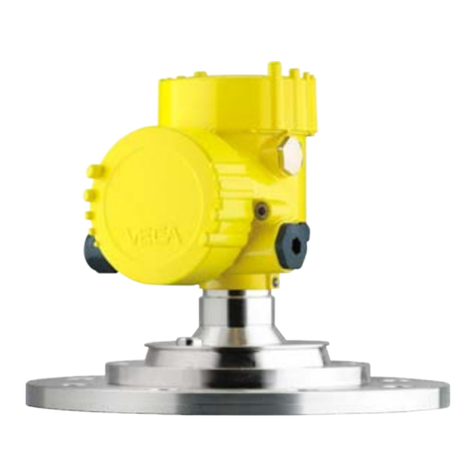
Vega
Vega VEGAPULS 69 User manual

Vega
Vega VEGACAP 63 User manual

Vega
Vega VEGAPULS 62 User manual
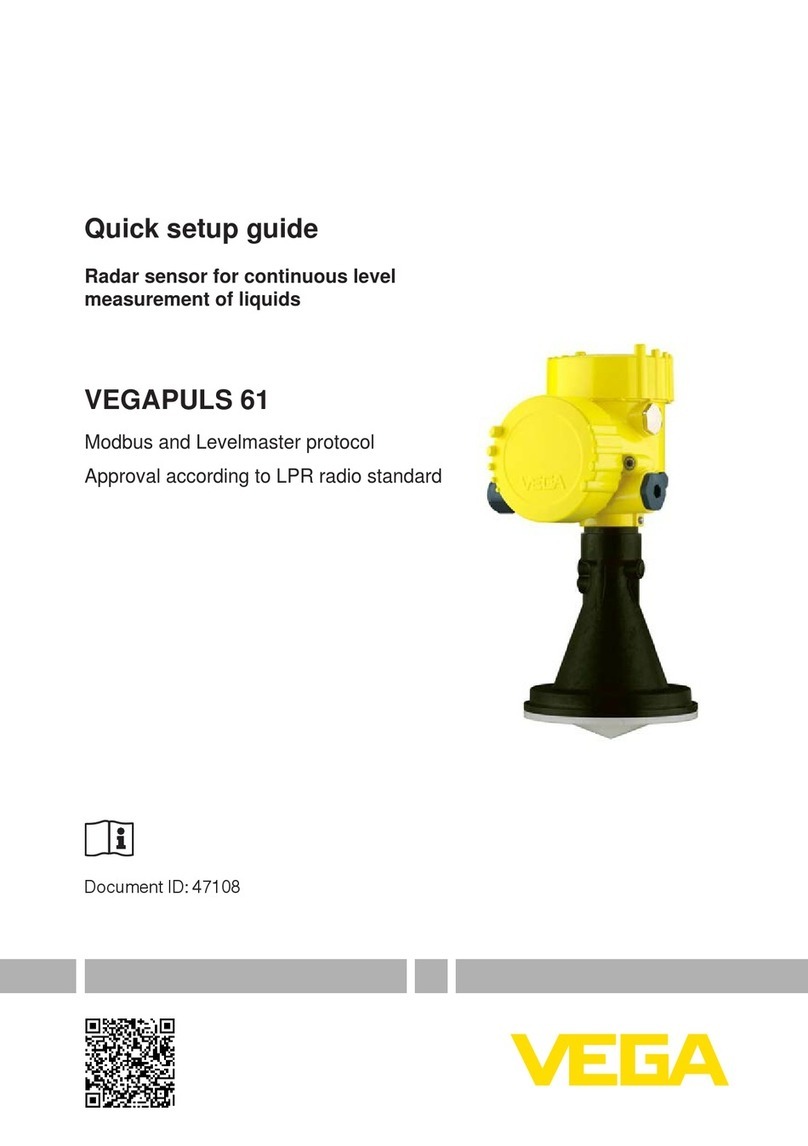
Vega
Vega VEGAPULS 61 User manual
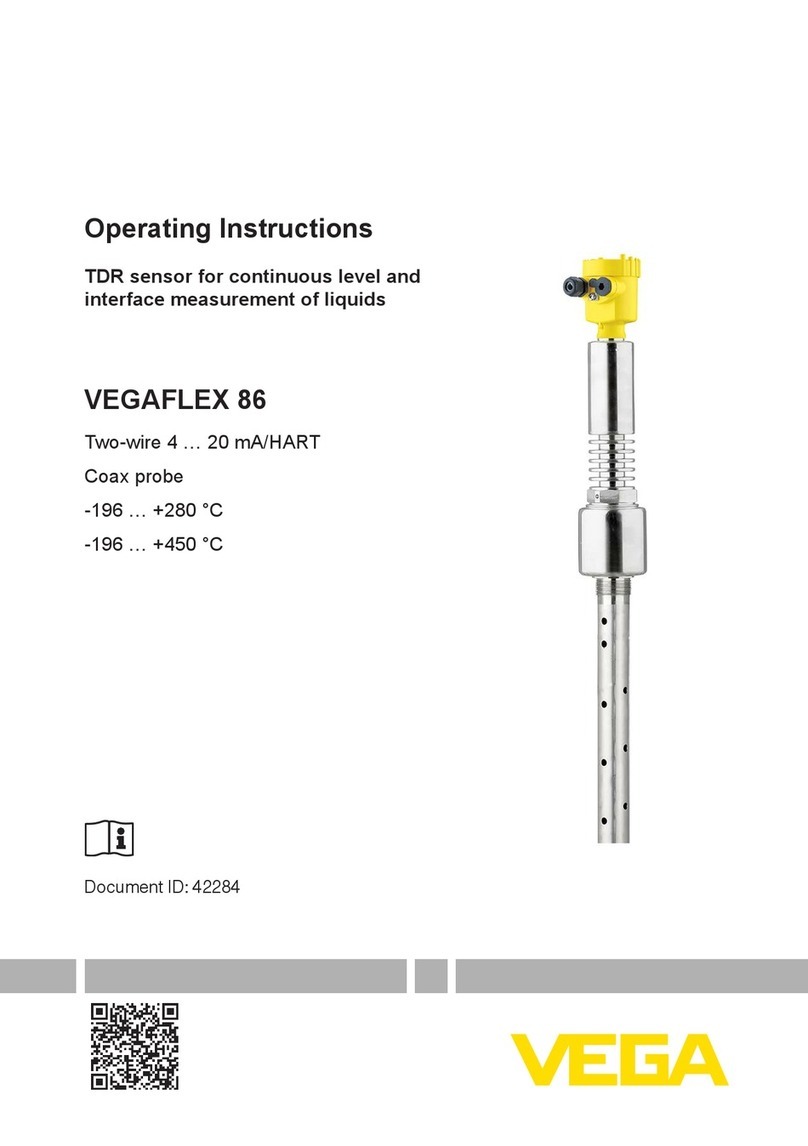
Vega
Vega VEGAFLEX 86 User manual
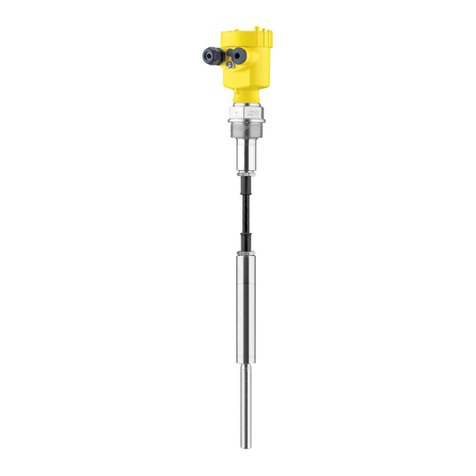
Vega
Vega VEGAVIB 62 User manual

Vega
Vega VEGADIS 61 User manual

Vega
Vega VEGAPULS 69 User manual

Vega
Vega VEGAPULS 62 User manual
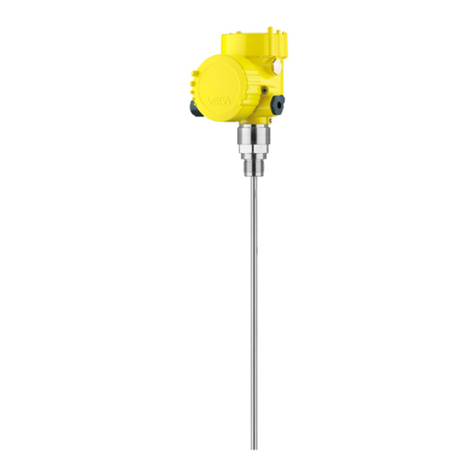
Vega
Vega VEGAFLEX 81 User manual
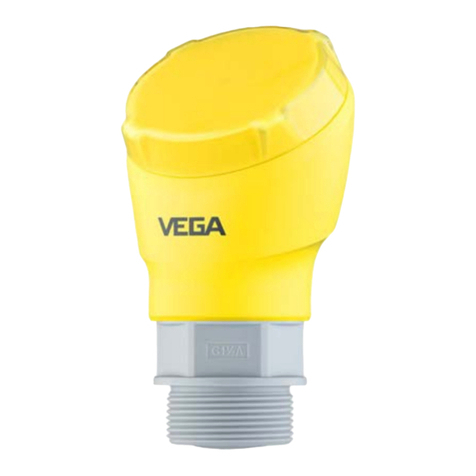
Vega
Vega VEGAPULS 11 User manual
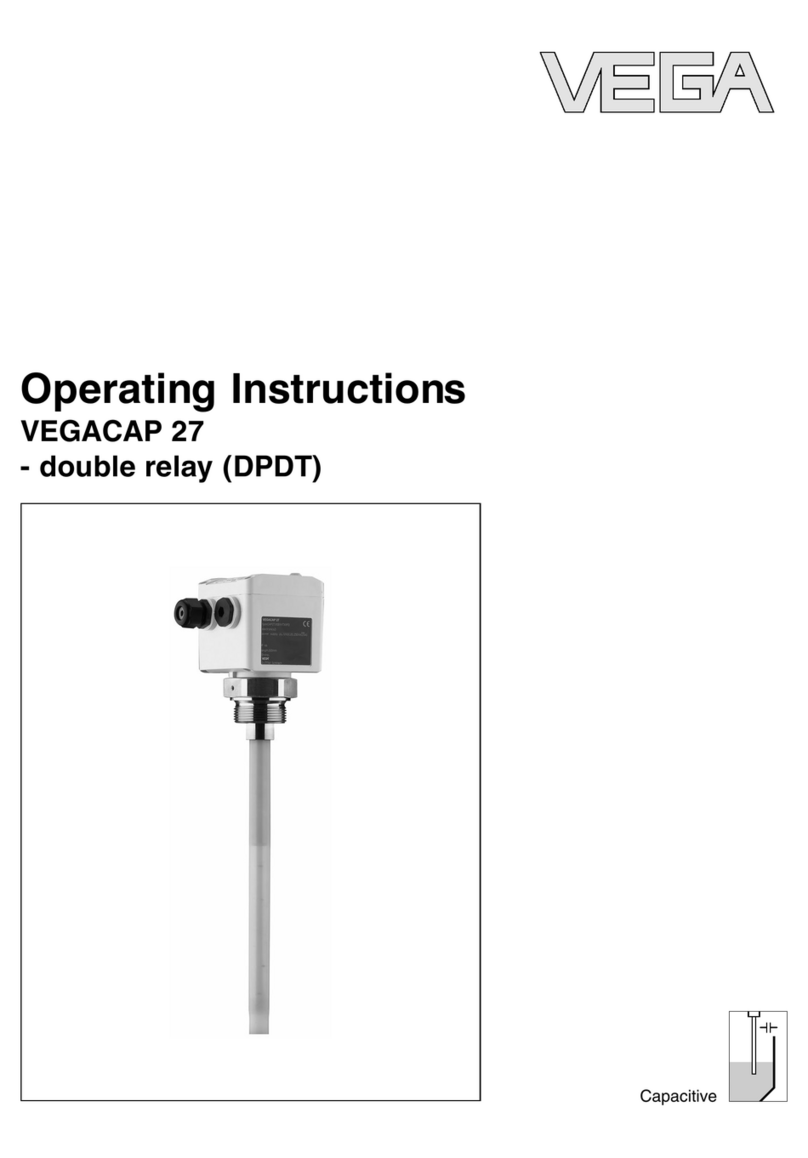
Vega
Vega VEGACAP 27 User manual

Vega
Vega VEGAPULS 61 User manual

Vega
Vega VEGABAR 28 User manual
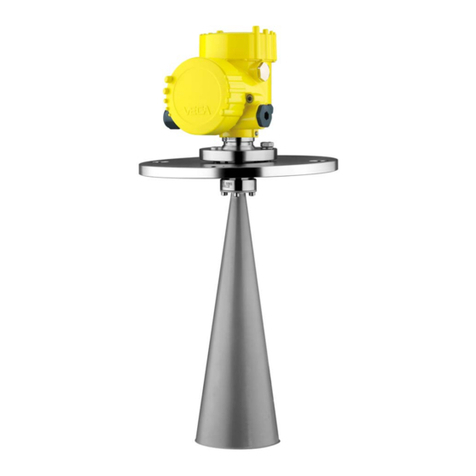
Vega
Vega VEGAPULS 68 User manual
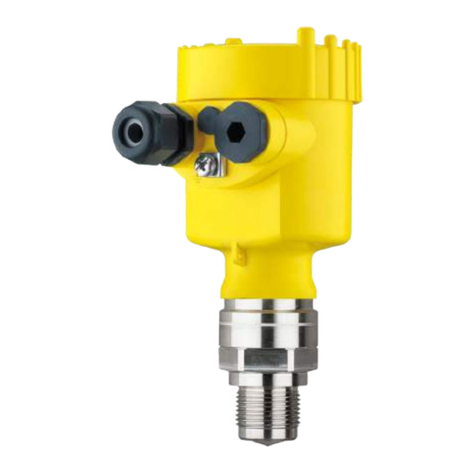
Vega
Vega VEGAPULS 6X User manual
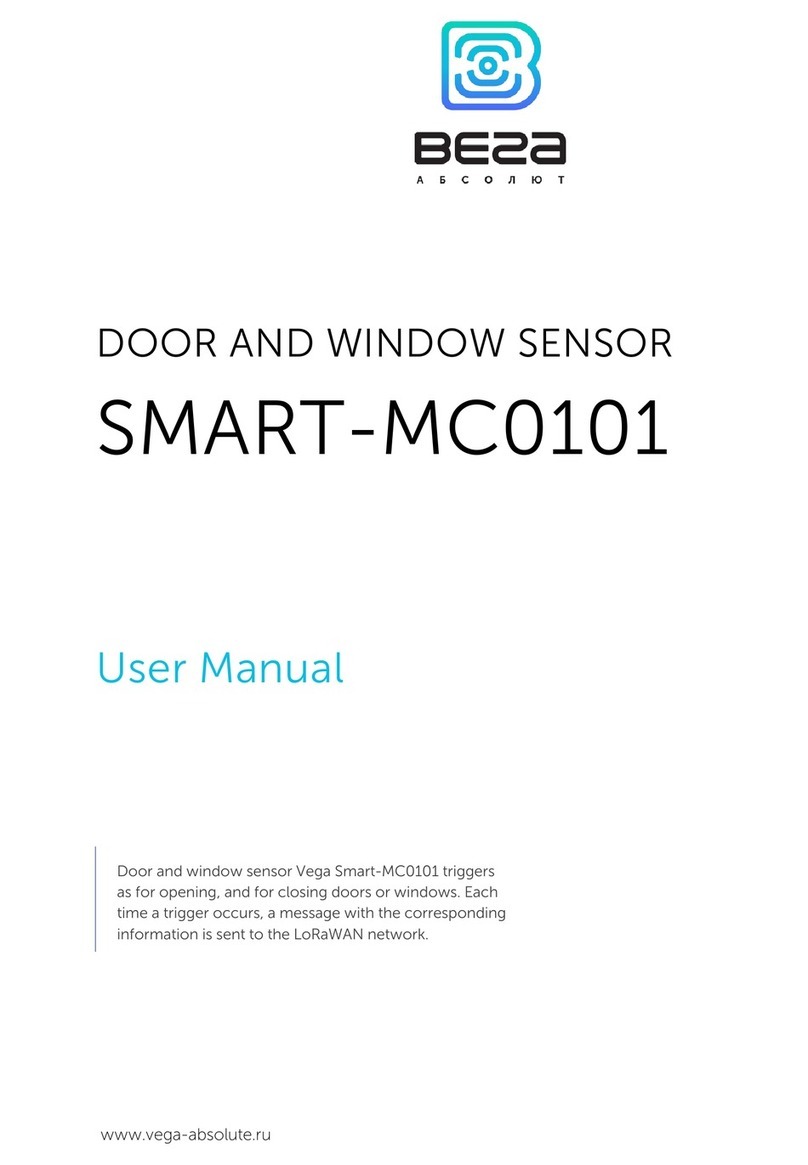
Vega
Vega SMART-MC0101 User manual

Vega
Vega VEGAFLEX 81 User manual

Vega
Vega VEGAPULS Air 23 User manual

Vega
Vega VEGAPULS WL 61 User manual





















